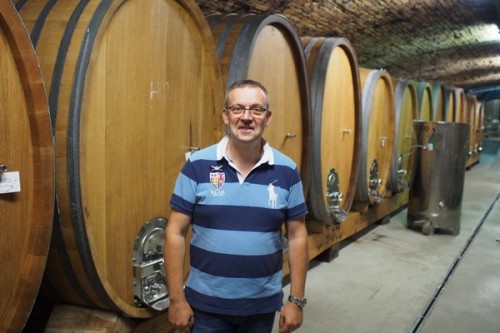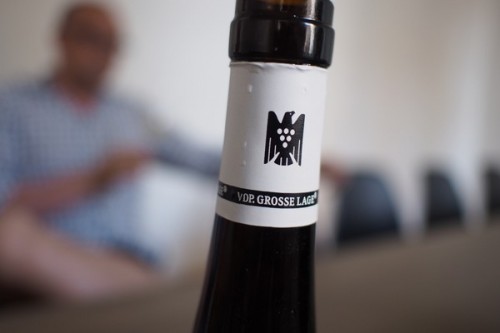
Today I visited Riechsrat von Buhl. This was once on the the great wine estates not just of Germany, but in the world. Over the years, bits of the estate had been sold, and it ended up at its current size of just over 50 hectares of vineyard. However, its vineyard holdings, albeit reduced, are quite amazing, with the best sites in Deidesheim, Forst and Ruppertsberg, including Kirchenstück, Pechstein, Jesuitengarten, Freundstück, Leinhöhle, Herrgottsacker, Kiesleberg and Paradiesgarten.

In 2005 the winery was bought by Achim Niederberger, but at the time it was leased to Japanese business man Toyohiro Tokuoka. So Achim had eight years to build his team, and in 2013 managing director Richard Grosche and winemaker Mathieu Kauffmann (who previously completed a 12 year stint in charge of Bollinger) took over. Grosche had convinced Achim (who sadly died in 2013) that von Buhl was a sleeping giant, with its astonishing vineyard holdings. Today’s tasting of Rieslings showed that the new regime is nailing it: these were truly brilliant wines.

The vineyards are now being managed biodynamically, and the cellar is just amazing. Mathieu has had to start again, buying new large oak (2400 litre dopplestücks, which differ markedly by manufacturer, he says) each year to repopulate the stunning underground facility so that he can make the wines he likes. He favours large oak, minimal use of sulfur dioxide during vilification, long lees ageing and minimal movement of the wine.

‘It has taken three years to get people to understand why we are doing things this way,’ says Richard Grosche. ‘It has been tough.’ This transition has involved replanting significant portions of their vineyards, and also making wines in a tighter, leaner style that will repay ageing. These are truly impressive wines.
Von Buhl Deidesheimer Kieselberg Riesling GG 2015 Pfalz, Germany
Didn’t make a GG there for the first two years. Do 30% green harvest. East facing with coloured sandstone soils and a bit of loess. Powerful, intense and lemony with white peach and pear fruit. Lovely intensity and complexity. 95% oak fermented and aged, but it’s brilliantly integrated. Lovely depth, richness and complexity with fine spiciness. Melon, mango and lemons here. Subtle smoky notes here, too. Quite profound and pure with richness but also brightness. 95/100
Von Buhl Forster Jesuitengarten Riesling GG 2015 Pfalz, Germany
7.8 ha vineyard site, second-highest graded in the 1826 evalualtion. Nice mix of coloured sandstone, limestone and basalt. Fermented in large new oak (bought 7 dopplestück, and then repeated that, then 4 and 6). 11 months on gross lees. Fine, aromatic, pure and spicy with lemon and passionfruit, together with a hint of dried apricot. The palate is expressive and spicy with lovely precision and weight. Very pure and linear with a hint of creaminess on the palate. Zippy, spicy, linear finish. Quite stony and mineral. 95/100

Von Buhl Forster Ungeheuer Riesling GG 2015 Pfalz, Germany
27 hectare vineyard. Basalt and coloured sandstone, and a bit of limestone. Von Buhl have very good plots here. Very linear and mineral with a hint of reduction. Tight and primary with lovely delicacy to the aromatics, showing some spiciness and some lemons. Concentrated, stony, focused and mineral on the palate with lovely precision. A very mineral style that has a long way to go. So much potential here. There’s a real focus here. So vivid and detailed. 96/100

Von Buhl Forster Pechstein Riesling GG 2015 Pfalz, Germany
Strongest collection of basalt of all the vineyards. Intense, saline, mineral with lovely fruits. Very dry with lemons, fine herbs, some coriander. Lovely mineral character here. Electric and finely spiced on the palate with an incredibly long finish. So lean and pure with amazing potential for development. Truly world class with fabulous potential. A special wine. 96/100
Von Buhl Ruppertsberger Reiterpfad ‘In der Hohl’ GG 2015 Pfalz, Germany
Broad and intense. 10 year old vineyards. Very ripe and fruity with lovely melon, mango and spice notes. Rich and intense with lovely pear and melon fruit. The sandy soils accentuate the fruitiness. Lovely citrus peel too. Very fruity and bold with lovely richness. 93/100
Von Buhl Diedersheimer Paradiesgarten Erste Lage 2014 Pfalz, Germany
Very fine, lemony and bright with lovely juicy, linear stony citrus fruit. Very direct and linear with lovely precision. A bit of pithiness but lovely purity here. Lemony, direct and primary. 93/100
Von Buhl Forster Freundstück Riesling GG 2014 Pfalz, Germany
Great concentration and focus here to this really linear, bright, lemony Riesling. Tight and precise and a little austere but with elegance and delicacy. Dry and intensely mineral with lemony acidity on the finish, and pronounced acidity. This will last a long time. Serious stuff, but drink it in a while. Stony. Profound. 94/100

Von Buhl Ruppertsberger Reiterpfad Hofstück Riesling GG 2014 Pfalz, Germany
Complex, profound nose of lemons, white peach and subtle herbs. Some honeysuckle, too. The palate is fresh and herb-tinged with bright grapefruit and orange peel characters, but the clear focus is precise lemony fruit. So fresh and fine. Steely and intense with lovely precision and purity. Has a subtle green note and admirable precision. Limestone and coloured sandstone, with a lot of limestone 10 metres down. Superb linear style with great potential. 95/100
Find these wines with wine-searcher.com
1 Comment on Von Buhl: an estate reborn, with incredible Rieslings from the Pfalz
I’m in a anthropology class focused on wine and in the class we were each assigned a noble grape to research. My grape was the Riesling, so I found this article very interesting. The descriptions of these wines stayed true to all else I’ve heard. However, I’ve heard that some Riesling wines have a hint of kerosene in their scent. Was this experienced in any of the wines you tried? Or is the kerosene scent primarily in older Rieslings?
I was also curious about the proximity of this vineyard to the Mosel region of Germany and how their growing techniques compare to the techniques used in the Mosal region. For example, are the vines from Von Buhl grown on slopping hillsides in rocky soils? How long do they typically stay on the vines?
Thanks for this post. It was great to read about the history of the winery and hear about some of the great wines it produced.